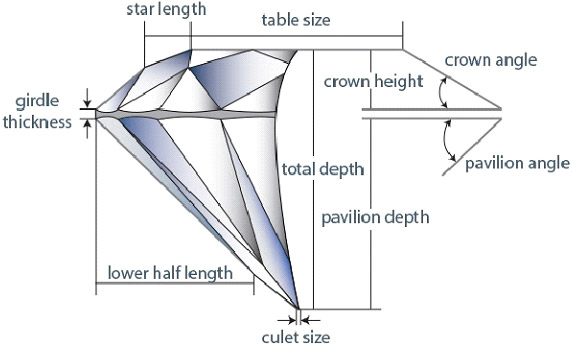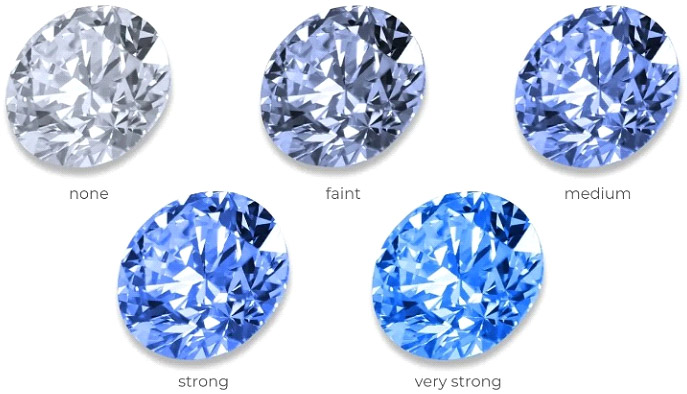Diamond Anatomy
While every diamond is unique, all diamonds share certain structural features. A diamond anatomy, or its basic structure, determines its proportions, brilliance, dispersion and scintillation. Each part of the diamond has a specific name, and having a basic understanding of how each part contributes to the diamond as a whole will help you find your perfect diamond. A diamond is comprised of the eight main components. They are Diameter, Table, Crown, Table Spread, Girdle, Pavilion, Depth, and Culet. Below is a brief description of each part of a diamond and its location.

Diamond Care
Cleaning your diamond jewelry
Depending on the setting you choose, you can soak your diamond engagement and/or wedding rings for up to 30 minutes in a solution of dishwashing liquid and water. This is best suited to prong and cathedral settings. In pave and basket settings, however, soaking the rings can increase the likelihood of the gems coming loose. Be mindful of this when you decide to soak any jewelry piece use mild dish soap in warm water and soak your jewelry for a few minutes. Using a soft cloth or cotton swab, gently scrub the metal (gold, platinum, silver) and then rinse. Repeat the process if necessary, but always proceed with caution when it comes to soaking jewelry.
For extra shine, you can soak diamonds in window cleaner afterwards. Because glass cleaner contains some harsh chemicals, do not soak for more than a minute at a time, and do not use this process at all with rhodium. To ensure that all of the glass cleaner is rinsed off, use the same mild dish soap solution. Dip your ring into the solution, rinse it with warm water, and then dry it completely.
You can use toothpicks to remove dirt that is lodged in between the prongs and the diamonds, but be extra careful not to scratch the metal or move the positioning of a prong. If fibers from cloth get stuck in the setting, gently use tweezers to remove them. Again, be careful of the metal. Even though diamonds can only be scratched by other diamonds, the precious metals into which they are set can be scratched more easily.
Ionic cleaners can be used on most diamond jewelry. If your engagement ring is set with stones other than diamonds, consider other cleaning methods, as some gemstones are adversely affected by the electrical current in the ionic cleaning process.
When storing your diamond jewelry, be sure to keep it separate from other jewelry. Remember that diamonds can not only scratch any other jewelry you have, but can scratch each other as well. Make sure that two diamond pieces are not being stored in such a way that they touch each other.
Insuring your Diamond Jewelry
Once you have purchased your beautiful diamond jewelry, you will want to make sure that it is properly insured, in the event of theft or loss. Although homeowner's and renter's policies will cover a portion of your jewelry loss, it is often a small amount in comparison to the original cost of a diamond engagement ring or wedding ring. It is advisable to find out how much is covered by the policies you have in place, and then look into additional policies
If you choose to get additional insurance, find out if there is a deductible and how much it is. Most insurance companies will not insure fine jewelry without an appraisal, so make sure you find out which appraisal reports are acceptable to your insurance company. Ask if the policy covers you fully, whether the item is merely damaged, or even if it is lost overseas. Many policies will have riders that do not allow for this level of coverage. Make sure you read the details of the policy carefully before you pay for extra insurance. Also find out if your jewelry is covered at the full replacement cost, and if you can receive a cash settlement in lieu of a replacement item.
Be aware that your insurance company may require updated appraisals on a regular basis. Be prepared to have your jewelry appraised every few years. Ask what the rules are for the particular insurance company you choose. Also find out if there is a discount if you have a home security system, such as an alarm system.
When you invest in diamond jewelry, you want to make sure that your investment is protected. Research insurance companies online or call around for information to make comparisons before you choose.
FLUORESCENCE
What is diamond fluorescence?
Fluorescence is a naturally occurring phenomenon that appears in certain minerals and gems. Some quality diamonds display a visible light when they are exposed to ultraviolet light. This light is known as fluorescence. Under most lighting conditions, a diamond's fluorescence is not visible to the naked eye, although the diamond will exhibit a soft colored glow if held under an ultraviolet lamp.
Do all diamond fluoresce?
Not all diamond fluoresce. If a specific diamond does not fluoresce, the grading report will list the diamond's fluorescence as either inert or none.
What are the different types of diamond fluorescence?
The degree of fluorescence varies from faint to medium to strong to very strong. Faint means that the stone has a slight glow that is difficult to see under ultraviolet light. Very strong means that the diamond emits a deep glow that is very clear under ultraviolet light. The color of the fluorescence can also vary, although blue is the most common color. Yellow, green and white are other colors that a fluorescent diamond may exhibit.
How does fluorescence affect a diamond?
Fluorescence usually has no effect on a diamond's appearance in regular lighting conditions. In some cases, however, a strong blue fluorescence can make a yellow colored diamond appear whiter. In rare cases, it can or cause a stone to appear milky or oily.

Twara Diam TODAY.